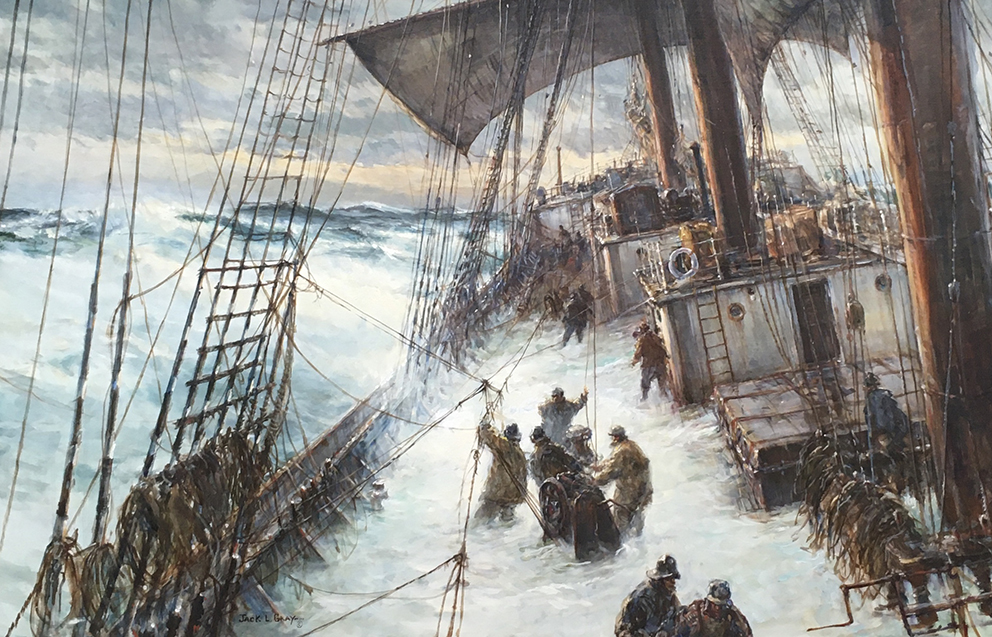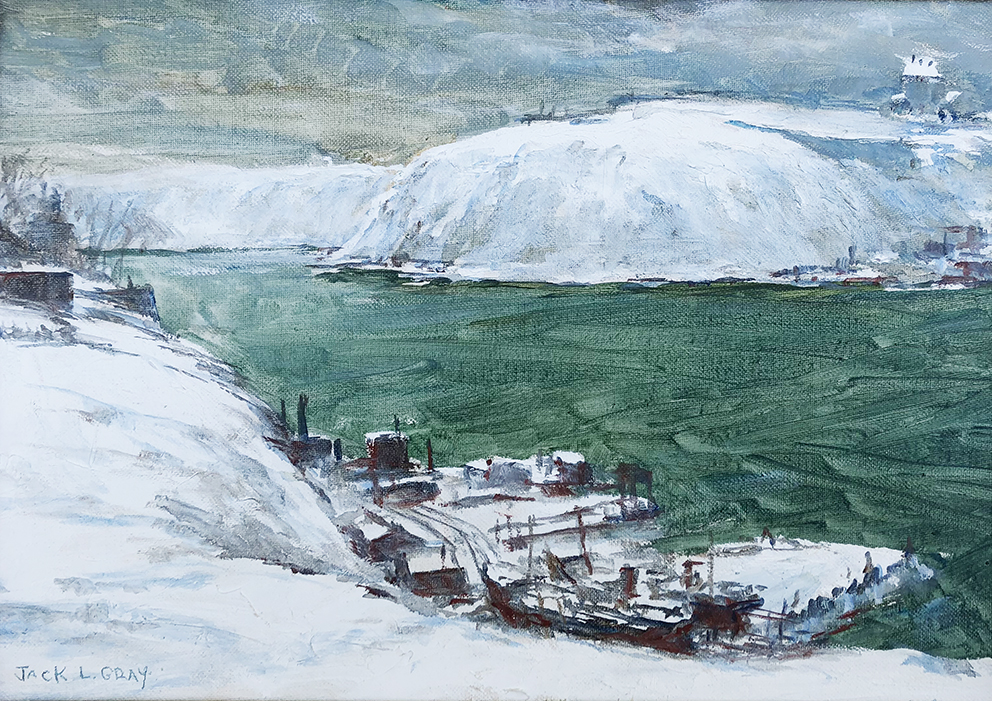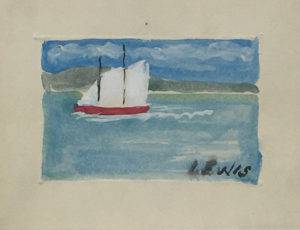Enjoy our collection of Jack Gray paintings for sale, if you have any question or would like more detailed pictures please e-mail us at info@atlanticfineart.com. We are always looking to acquire Jack's work, if you're looking to sell any pieces please contact us at info@atlanticfineart.com.
Decks Away — Jack L. Gray

Decks Away — Jack L. Gray
Oil on Canvas
Image Size: 26½"x 40"
Price: SOLD
Details: Signed front, Wunderlich Gallery stamp
Framed: Measures approximately 32" x 46".
Provenance: Certificate of authenticity and insurance appraisal from Zwickers Gallery Halifax.
Click Here to Purchase or Inquire
Quebec City — Jack L. Gray

Quebec City — Jack L. Gray
Oil on Canvas
Image Size: 10"x 14"
Price: SOLD
Details: Signed front, newly cleaned and framed
Framed: Measures approximately 21 x 25 inches.
Provenance: Private collection, Nova Scotia.
Click Here to Purchase or Inquire
Biography:
Early life and education
Jack L. Gray was born in Halifax, Nova Scotia on April 28, 1927, the only child of civil engineer Samuel William Gray. Growing up in the South End of Halifax, he was a pupil at Tower Road School. As a schoolboy young Jack loved drawing pictures, especially those of ships at sea, and his talent was recognized and encouraged by Sir Edmund Wyly Grier. By the end of World War II he was a student at the Nova Scotia College of Art and Design (NSCAD) during the tenure of Donald Cameron MacKay. At the art college, Gray was mentored by several painters, including Elizabeth Styring Nutt and David Whitzman. It was here that the young Gray met fellow artists Earl Bailly and Joseph Purcell. In the summer of 1945 Gray boarded with the Young family of East Ironbound island and made many sketches of island life which subsequently were turned into large paintings. After two years of studies at NSCAD, he left the school and went on sketching trips both alone and also with Purcell, his former classmate. During the summer of 1947, the two artists rented the loft of a fish store at New Harbour, Nova Scotia and made many drawings and paintings. Gray travelled briefly to Montreal in 1948 to take a life drawing course from Arthur Lismer at the Montreal Museum of Fine Arts. Gray was observed sketching a boat hull in the class, and the instructor commented that, given that a future course might be offered in boat drawing, Gray likely would then be found drawing a nude. Jack's evident lack of interest in Lismer's classroom sessions soon led to private discussions between the two artists, which proved fruitful. In those years Gray also spent several seasons at sea with the last of Lunenburg, Nova Scotia's dory-fishing schooner fleet, and amassed a portfolio of sketches, notes and photographs.
Career
His first major solo exhibition was at the Hackmatack Inn in Chester, Nova Scotia in 1948, leading to several commissions. With subsequent patronage from the Philadelphia dowager heiress Mary Dayton Cavendish, Maritime brewery owner Sidney C. Oland and others in the Oland family, Gray gradually advanced his career, living aboard boats in the early 1950s. When the steamship Dufferin Bell was wrecked on the Nova Scotian coast in 1951, Gray travelled with the salvage crew and filled several sketchbooks, attracting the attention of the press. An early friendship with author Thomas Head Raddall led to Gray's pen-and-ink illustrations in Raddall's A Muster of Arms (1954); Gray also painted a wartime scene of Duncan's Cove, Nova Scotia for the book's dust jacket. While based in Chester in the summers from 1953 to 1955, he painted in (his landlord) Herman Walker's sail loft in the Back Harbour.
In the mid-1950s Gray moved to New York City and initially painted in studios on boats in Flushing Bay. It was here that he first used the cantankerous flat-bottomed skiff he called the S.O.B. for waterborne sketching trips. For one of his sketches, Gray obtained permission from authorities in Brooklyn Navy Yard to use the deck of the rusting decommissioned aircraft carrier USS Enterprise (CV-6). His first New York showing was at the invitation of the Port Authority of New York and New Jersey in 1955. He was represented by Rudolf Wunderlich's Kennedy Galleries on 57th Street while living in the city, and briefly occupied one of the Des Artistes flats in the Upper West Side. A body of work from this period later became a well-known series of reproductions, the New York Harbor Collection. However, the collection was incomplete since many of the significant canvas works from that period were already sold. While in New York, Gray became acquainted with folksinger Ed McCurdy, and the two remained lifelong friends.
Poster for John Paul Jones, released in 1959.
In 1958 an engagement with Samuel Bronston's Hollywood production company took Gray to Spain, where he worked on posters for the film John Paul Jones.
With encouragement from US district attorney (later Senator) E. Donald Finnegan[who?], Gray moved in 1959 to Winterport, Maine, settling in an 18th-century Cape Cod on the banks of the Penobscot River. There he created a series of paintings, of which later critics, notably art expert Ian Muncaster of Halifax, would characterize as his best work. The Maine studio was short-lived, as Gray sold it in 1961 and moved to the Marlborough Woods area in the south end of Halifax, purchasing a property on the Northwest Arm, with a dock for his boat. Gray negotiated with New York publicity firm Peed & Gammon in 1961, who arranged for Gray's canvas Dressing Down, the Gully to find its way into the hands of newly elected US president John F. Kennedy. This resulted in a July 1962 visit to the White House in Washington by Gray, including a conversation with the President. Gammon and Peed had leaked this information in advance to the press, and upon publication of the White House visit news, bids from many patrons and galleries rapidly ensued. Gray remained friends with Roland Gammon for years afterwards.
Gray moved back aboard a boat in 1965, in West Palm Beach, Florida, and strengthened relationships with galleries on Palm Beach's Worth Avenue that had begun in the spring of 1961 and would remain in place for the rest of his life. Concurrently, Gray maintained a summer hideaway in Stonehurst, Nova Scotia, where he continued to sketch his favourite subject, inshore fishermen in small boats. Gray befriended actor Gary Merrill in Palm Beach. The noted Hollywood photographer Phil Stern visited Gray's Nova Scotia studio in the early 1970s and amassed a huge archive of photographic images of Gray and his surroundings. This photo essay was originally earmarked to be part of a book on the artist's life and work, but the book was abandoned incomplete and never published. A film taken of Gray in and around Stonehurst has recently been recovered from the estate of Phil Stern: http://www.ebay.com/itm/Vintage-16mm-Film-Artist-Jack-L-Gray-in-Nova-Scotia-Phil-Stern-Gary-Merrill-/221782845569
In his adult years Gray was known as a witty raconteur and motorboat skipper, and in the latter part of his life often sailed across the Gulf Stream to the Bahamas. He was a frequent visitor to the Blue Bee Bar in New Plymouth, Green Turtle Cay and was a personal friend to (proprietor) Miss Emily Cooper.
Gray had many exhibitions in the 1970s throughout the world. Most unusual of these was the Spring 1978 retrospective exhibition in Halifax, held in the old powder magazine on Citadel Hill.
Source: Wikipedia
